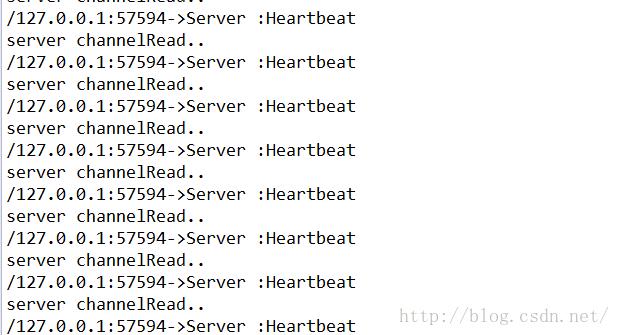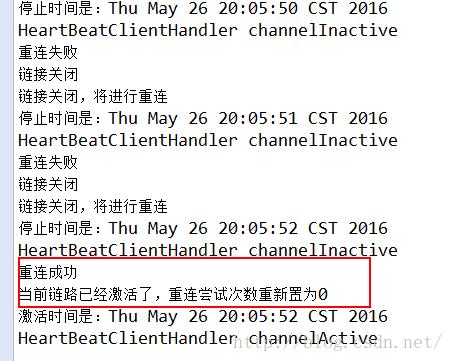一起学Netty(十四)之 Netty生产级的心跳和重连机制
Posted BazingaLyncc
tags:
篇首语:本文由小常识网(cha138.com)小编为大家整理,主要介绍了一起学Netty(十四)之 Netty生产级的心跳和重连机制相关的知识,希望对你有一定的参考价值。
sigh,写这篇博客的时候老脸还是红了一下,心里还是有些唏嘘的,应该算是剽窃吧,每个人的代码功力的确是有差距的,好在文章的标题是“一起学”,而不是开涛大神的“跟我学”系列的文章,我们还是多花点时间学习吧,感叹无用~
最近工作比较忙,但闲暇之余还是看了阿里的冯家春(fengjiachun)的github上的开源代码Jupiter,写的RPC框架让我感叹人外有人,废话不多说,下面的代码全部截取自Jupiter,写了一个比较完整的例子,供大家一起学习分享,再次对@Luca抱拳,Jupiter的Github地址:
https://github.com/fengjiachun/Jupiter
今天研究的是,心跳和重连,虽然这次是大神写的代码,但是万变不离其宗,我们先回顾一下Netty应用心跳和重连的整个过程:
1)客户端连接服务端
2)在客户端的的ChannelPipeline中加入一个比较特殊的IdleStateHandler,设置一下客户端的写空闲时间,例如5s
3)当客户端的所有ChannelHandler中4s内没有write事件,则会触发userEventTriggered方法(上文介绍过)
4)我们在客户端的userEventTriggered中对应的触发事件下发送一个心跳包给服务端,检测服务端是否还存活,防止服务端已经宕机,客户端还不知道
5)同样,服务端要对心跳包做出响应,其实给客户端最好的回复就是“不回复”,这样可以服务端的压力,假如有10w个空闲Idle的连接,那么服务端光发送心跳回复,则也是费事的事情,那么怎么才能告诉客户端它还活着呢,其实很简单,因为5s服务端都会收到来自客户端的心跳信息,那么如果10秒内收不到,服务端可以认为客户端挂了,可以close链路
6)加入服务端因为什么因素导致宕机的话,就会关闭所有的链路链接,所以作为客户端要做的事情就是短线重连
以上描述的就是整个心跳和重连的整个过程,虽然很简单,上一篇blog也写了一个Demo,简单地做了一下上述功能
要写工业级的Netty心跳重连的代码,需要解决一下几个问题:
1)ChannelPipeline中的ChannelHandlers的维护,首次连接和重连都需要对ChannelHandlers进行管理
2)重连对象的管理,也就是bootstrap对象的管理
3)重连机制编写
完整的代码:https://github.com/BazingaLyn/netty-study/tree/master/src/main/java/com/lyncc/netty/idle
下面我们就看大神是如何解决这些问题的,首先先定义一个接口ChannelHandlerHolder,用来保管ChannelPipeline中的Handlers的
package com.lyncc.netty.idle;
import io.netty.channel.ChannelHandler;
/**
*
* 客户端的ChannelHandler集合,由子类实现,这样做的好处:
* 继承这个接口的所有子类可以很方便地获取ChannelPipeline中的Handlers
* 获取到handlers之后方便ChannelPipeline中的handler的初始化和在重连的时候也能很方便
* 地获取所有的handlers
*/
public interface ChannelHandlerHolder {
ChannelHandler[] handlers();
}
HeartBeatServer.java
package com.lyncc.netty.idle;
import io.netty.bootstrap.ServerBootstrap;
import io.netty.channel.ChannelFuture;
import io.netty.channel.ChannelInitializer;
import io.netty.channel.ChannelOption;
import io.netty.channel.EventLoopGroup;
import io.netty.channel.nio.NioEventLoopGroup;
import io.netty.channel.socket.SocketChannel;
import io.netty.channel.socket.nio.NioserverSocketChannel;
import io.netty.handler.codec.string.StringDecoder;
import io.netty.handler.codec.string.StringEncoder;
import io.netty.handler.logging.LogLevel;
import io.netty.handler.logging.LoggingHandler;
import io.netty.handler.timeout.IdleStateHandler;
import java.net.InetSocketAddress;
import java.util.concurrent.TimeUnit;
public class HeartBeatServer {
private final AcceptorIdleStateTrigger idleStateTrigger = new AcceptorIdleStateTrigger();
private int port;
public HeartBeatServer(int port) {
this.port = port;
}
public void start() {
EventLoopGroup bossGroup = new NioEventLoopGroup(1);
EventLoopGroup workerGroup = new NioEventLoopGroup();
try {
ServerBootstrap sbs = new ServerBootstrap().group(bossGroup, workerGroup)
.channel(NioServerSocketChannel.class).handler(new LoggingHandler(LogLevel.INFO))
.localAddress(new InetSocketAddress(port)).childHandler(new ChannelInitializer<SocketChannel>() {
protected void initChannel(SocketChannel ch) throws Exception {
ch.pipeline().addLast(new IdleStateHandler(5, 0, 0, TimeUnit.SECONDS));
ch.pipeline().addLast(idleStateTrigger);
ch.pipeline().addLast("decoder", new StringDecoder());
ch.pipeline().addLast("encoder", new StringEncoder());
ch.pipeline().addLast(new HeartBeatServerHandler());
};
}).option(ChannelOption.SO_BACKLOG, 128).childOption(ChannelOption.SO_KEEPALIVE, true);
// 绑定端口,开始接收进来的连接
ChannelFuture future = sbs.bind(port).sync();
System.out.println("Server start listen at " + port);
future.channel().closeFuture().sync();
} catch (Exception e) {
bossGroup.shutdownGracefully();
workerGroup.shutdownGracefully();
}
}
public static void main(String[] args) throws Exception {
int port;
if (args.length > 0) {
port = Integer.parseInt(args[0]);
} else {
port = 8080;
}
new HeartBeatServer(port).start();
}
}
package com.lyncc.netty.idle;
import io.netty.channel.ChannelHandler;
import io.netty.channel.ChannelHandlerContext;
import io.netty.channel.ChannelInboundHandlerAdapter;
import io.netty.handler.timeout.IdleState;
import io.netty.handler.timeout.IdleStateEvent;
@ChannelHandler.Sharable
public class AcceptorIdleStateTrigger extends ChannelInboundHandlerAdapter {
@Override
public void userEventTriggered(ChannelHandlerContext ctx, Object evt) throws Exception {
if (evt instanceof IdleStateEvent) {
IdleState state = ((IdleStateEvent) evt).state();
if (state == IdleState.READER_IDLE) {
throw new Exception("idle exception");
}
} else {
super.userEventTriggered(ctx, evt);
}
}
}
package com.lyncc.netty.idle;
import io.netty.channel.ChannelHandlerContext;
import io.netty.channel.ChannelInboundHandlerAdapter;
public class HeartBeatServerHandler extends ChannelInboundHandlerAdapter {
@Override
public void channelRead(ChannelHandlerContext ctx, Object msg) throws Exception {
System.out.println("server channelRead..");
System.out.println(ctx.channel().remoteAddress() + "->Server :" + msg.toString());
}
@Override
public void exceptionCaught(ChannelHandlerContext ctx, Throwable cause) throws Exception {
cause.printStackTrace();
ctx.close();
}
}
接下来就是重点,我们需要写一个类,这个类可以去观察链路是否断了,如果断了,进行循环的断线重连操作,ConnectionWatchdog,顾名思义,链路检测狗,我们先看完整代码:
package com.lyncc.netty.idle;
import io.netty.bootstrap.Bootstrap;
import io.netty.channel.Channel;
import io.netty.channel.ChannelFuture;
import io.netty.channel.ChannelFutureListener;
import io.netty.channel.ChannelHandler.Sharable;
import io.netty.channel.ChannelHandlerContext;
import io.netty.channel.ChannelInboundHandlerAdapter;
import io.netty.channel.ChannelInitializer;
import io.netty.util.Timeout;
import io.netty.util.Timer;
import io.netty.util.TimerTask;
import java.util.concurrent.TimeUnit;
/**
*
* 重连检测狗,当发现当前的链路不稳定关闭之后,进行12次重连
*/
@Sharable
public abstract class ConnectionWatchdog extends ChannelInboundHandlerAdapter implements TimerTask ,ChannelHandlerHolder{
private final Bootstrap bootstrap;
private final Timer timer;
private final int port;
private final String host;
private volatile boolean reconnect = true;
private int attempts;
public ConnectionWatchdog(Bootstrap bootstrap, Timer timer, int port,String host, boolean reconnect) {
this.bootstrap = bootstrap;
this.timer = timer;
this.port = port;
this.host = host;
this.reconnect = reconnect;
}
/**
* channel链路每次active的时候,将其连接的次数重新☞ 0
*/
@Override
public void channelActive(ChannelHandlerContext ctx) throws Exception {
System.out.println("当前链路已经激活了,重连尝试次数重新置为0");
attempts = 0;
ctx.fireChannelActive();
}
@Override
public void channelInactive(ChannelHandlerContext ctx) throws Exception {
System.out.println("链接关闭");
if(reconnect){
System.out.println("链接关闭,将进行重连");
if (attempts < 12) {
attempts++;
//重连的间隔时间会越来越长
int timeout = 2 << attempts;
timer.newTimeout(this, timeout, TimeUnit.MILLISECONDS);
}
}
ctx.fireChannelInactive();
}
public void run(Timeout timeout) throws Exception {
ChannelFuture future;
//bootstrap已经初始化好了,只需要将handler填入就可以了
synchronized (bootstrap) {
bootstrap.handler(new ChannelInitializer<Channel>() {
@Override
protected void initChannel(Channel ch) throws Exception {
ch.pipeline().addLast(handlers());
}
});
future = bootstrap.connect(host,port);
}
//future对象
future.addListener(new ChannelFutureListener() {
public void operationComplete(ChannelFuture f) throws Exception {
boolean succeed = f.isSuccess();
//如果重连失败,则调用ChannelInactive方法,再次出发重连事件,一直尝试12次,如果失败则不再重连
if (!succeed) {
System.out.println("重连失败");
f.channel().pipeline().fireChannelInactive();
}else{
System.out.println("重连成功");
}
}
});
}
}稍微分析一下:
1)继承了ChannelInboundHandlerAdapter,说明它也是Handler,也对,作为一个检测对象,肯定会放在链路中,否则怎么检测
2)实现了2个接口,TimeTask,ChannelHandlerHolder
①TimeTask,我们就要写run方法,这应该是一个定时任务,这个定时任务做的事情应该是重连的工作
②ChannelHandlerHolder的接口,这个接口我们刚才说过是维护的所有的Handlers,因为在重连的时候需要获取Handlers
3)bootstrap对象,重连的时候依旧需要这个对象
4)当链路断开的时候会触发channelInactive这个方法,也就说触发重连的导火索是从这边开始的
好了,我们这边再写次核心的HeartBeatsClient的代码:
package com.lyncc.netty.idle;
import io.netty.bootstrap.Bootstrap;
import io.netty.channel.Channel;
import io.netty.channel.ChannelFuture;
import io.netty.channel.ChannelHandler;
import io.netty.channel.ChannelInitializer;
import io.netty.channel.EventLoopGroup;
import io.netty.channel.nio.NioEventLoopGroup;
import io.netty.channel.socket.nio.NioSocketChannel;
import io.netty.handler.codec.string.StringDecoder;
import io.netty.handler.codec.string.StringEncoder;
import io.netty.handler.logging.LogLevel;
import io.netty.handler.logging.LoggingHandler;
import io.netty.handler.timeout.IdleStateHandler;
import io.netty.util.HashedWheelTimer;
import java.util.concurrent.TimeUnit;
public class HeartBeatsClient {
protected final HashedWheelTimer timer = new HashedWheelTimer();
private Bootstrap boot;
private final ConnectorIdleStateTrigger idleStateTrigger = new ConnectorIdleStateTrigger();
public void connect(int port, String host) throws Exception {
EventLoopGroup group = new NioEventLoopGroup();
boot = new Bootstrap();
boot.group(group).channel(NioSocketChannel.class).handler(new LoggingHandler(LogLevel.INFO));
final ConnectionWatchdog watchdog = new ConnectionWatchdog(boot, timer, port,host, true) {
public ChannelHandler[] handlers() {
return new ChannelHandler[] {
this,
new IdleStateHandler(0, 4, 0, TimeUnit.SECONDS),
idleStateTrigger,
new StringDecoder(),
new StringEncoder(),
new HeartBeatClientHandler()
};
}
};
ChannelFuture future;
//进行连接
try {
synchronized (boot) {
boot.handler(new ChannelInitializer<Channel>() {
//初始化channel
@Override
protected void initChannel(Channel ch) throws Exception {
ch.pipeline().addLast(watchdog.handlers());
}
});
future = boot.connect(host,port);
}
// 以下代码在synchronized同步块外面是安全的
future.sync();
} catch (Throwable t) {
throw new Exception("connects to fails", t);
}
}
/**
* @param args
* @throws Exception
*/
public static void main(String[] args) throws Exception {
int port = 8080;
if (args != null && args.length > 0) {
try {
port = Integer.valueOf(args[0]);
} catch (NumberFormatException e) {
// 采用默认值
}
}
new HeartBeatsClient().connect(port, "127.0.0.1");
}
}
1)创建了ConnectionWatchdog对象,自然要实现handlers方法
2)初始化好bootstrap对象
3)4秒内没有写操作,进行心跳触发,也就是IdleStateHandler这个方法
最后ConnectorIdleStateTrigger这个类
package com.lyncc.netty.idle;
import io.netty.buffer.ByteBuf;
import io.netty.buffer.Unpooled;
import io.netty.channel.ChannelHandler.Sharable;
import io.netty.channel.ChannelHandlerContext;
import io.netty.channel.ChannelInboundHandlerAdapter;
import io.netty.handler.timeout.IdleState;
import io.netty.handler.timeout.IdleStateEvent;
import io.netty.util.CharsetUtil;
@Sharable
public class ConnectorIdleStateTrigger extends ChannelInboundHandlerAdapter {
private static final ByteBuf HEARTBEAT_SEQUENCE = Unpooled.unreleasableBuffer(Unpooled.copiedBuffer("Heartbeat",
CharsetUtil.UTF_8));
@Override
public void userEventTriggered(ChannelHandlerContext ctx, Object evt) throws Exception {
if (evt instanceof IdleStateEvent) {
IdleState state = ((IdleStateEvent) evt).state();
if (state == IdleState.WRITER_IDLE) {
// write heartbeat to server
ctx.writeAndFlush(HEARTBEAT_SEQUENCE.duplicate());
}
} else {
super.userEventTriggered(ctx, evt);
}
}
}
package com.lyncc.netty.idle;
import io.netty.channel.ChannelHandler.Sharable;
import io.netty.channel.ChannelHandlerContext;
import io.netty.channel.ChannelInboundHandlerAdapter;
import io.netty.util.ReferenceCountUtil;
import java.util.Date;
@Sharable
public class HeartBeatClientHandler extends ChannelInboundHandlerAdapter {
@Override
public void channelActive(ChannelHandlerContext ctx) throws Exception {
System.out.println("激活时间是:"+new Date());
System.out.println("HeartBeatClientHandler channelActive");
ctx.fireChannelActive();
}
@Override
public void channelInactive(ChannelHandlerContext ctx) throws Exception {
System.out.println("停止时间是:"+new Date());
System.out.println("HeartBeatClientHandler channelInactive");
}
@Override
public void channelRead(ChannelHandlerContext ctx, Object msg) throws Exception {
String message = (String) msg;
System.out.println(message);
if (message.equals("Heartbeat")) {
ctx.write("has read message from server");
ctx.flush();
}
ReferenceCountUtil.release(msg);
}
}
好了,到此为止,所有的代码都贴完了,我们做一个简单的测试,按照常理,如果不出任何状况的话,客户端4秒发送心跳,服务端5秒才验证是不会断连的,所以我们在启动之后,关闭服务端,然后再次重启服务端
首先启动服务端,控制台如下:

启动客户端,控制台如下:

客户端启动之后,服务端的控制台:

关闭服务端后,客户端控制台:

重启启动服务端:

重连成功~
以上是关于一起学Netty(十四)之 Netty生产级的心跳和重连机制的主要内容,如果未能解决你的问题,请参考以下文章